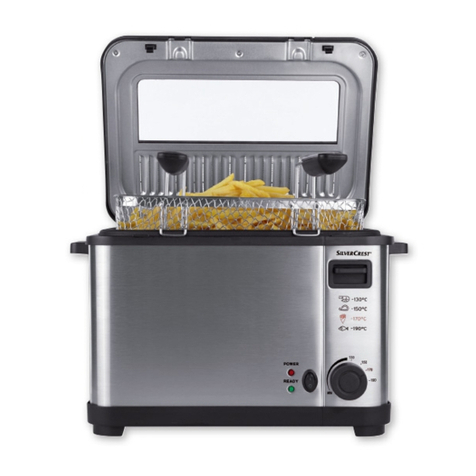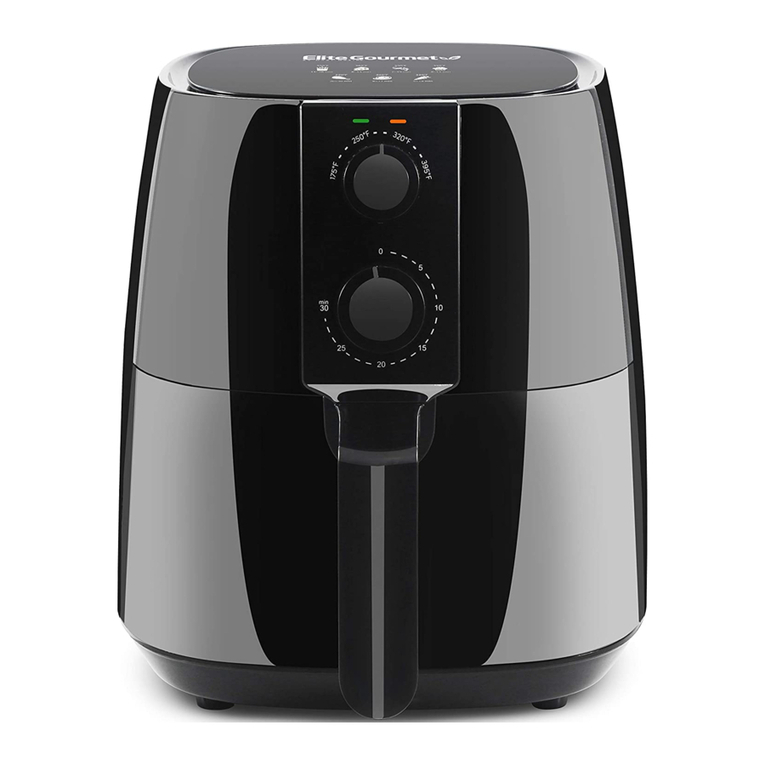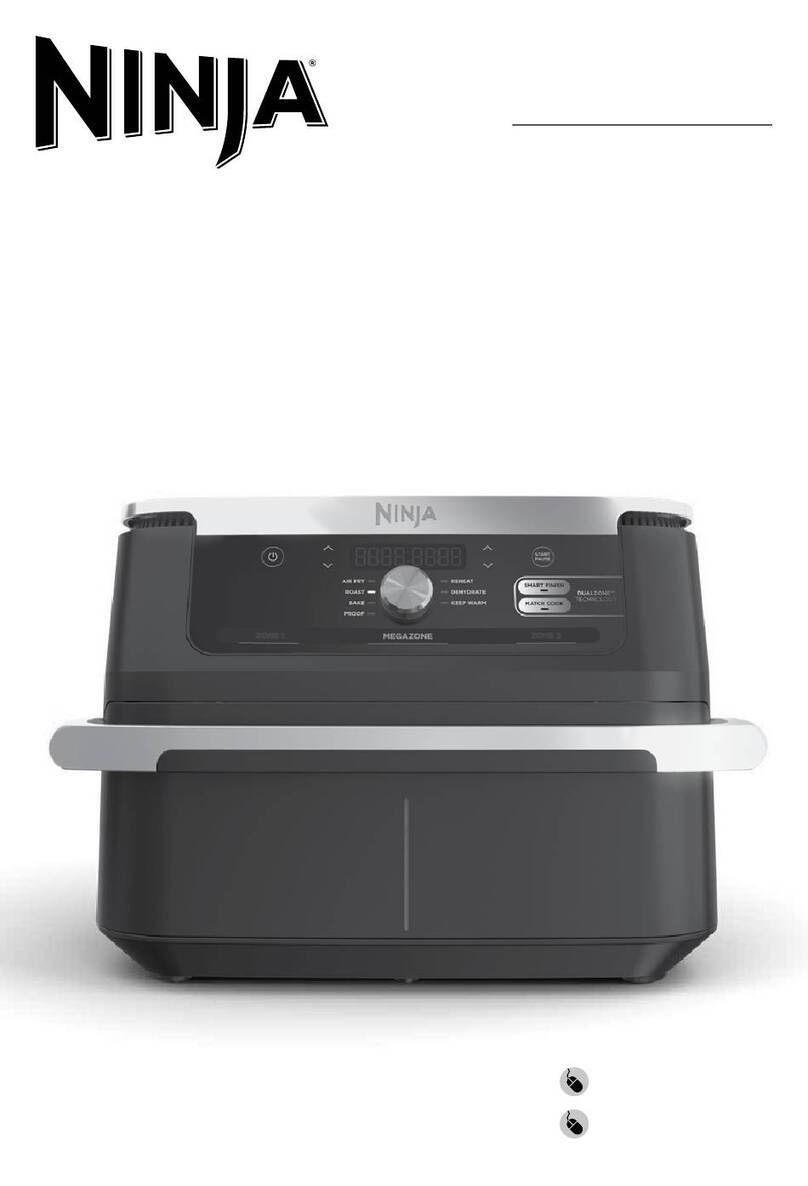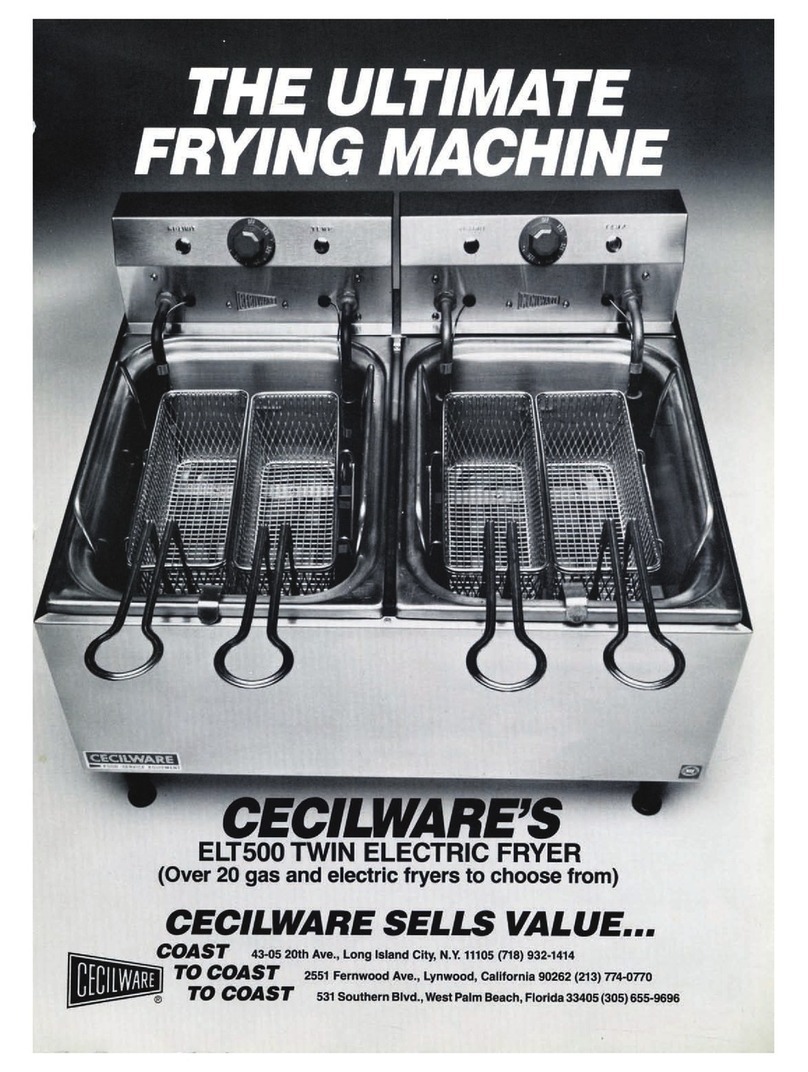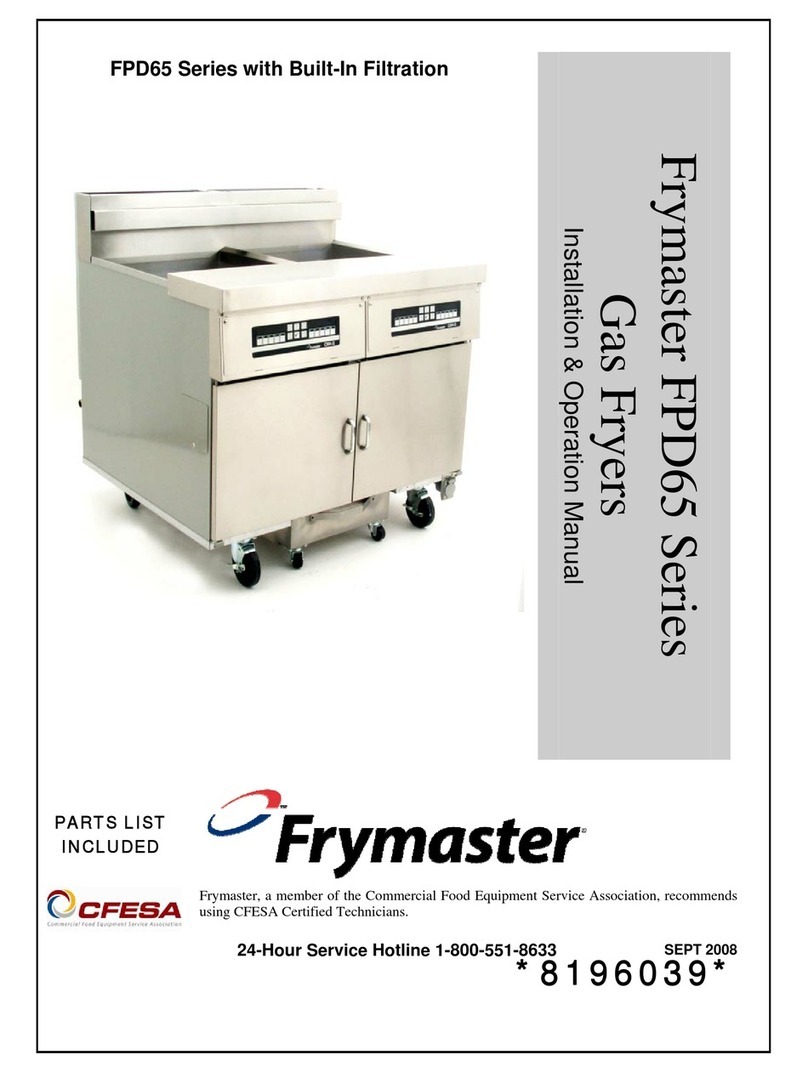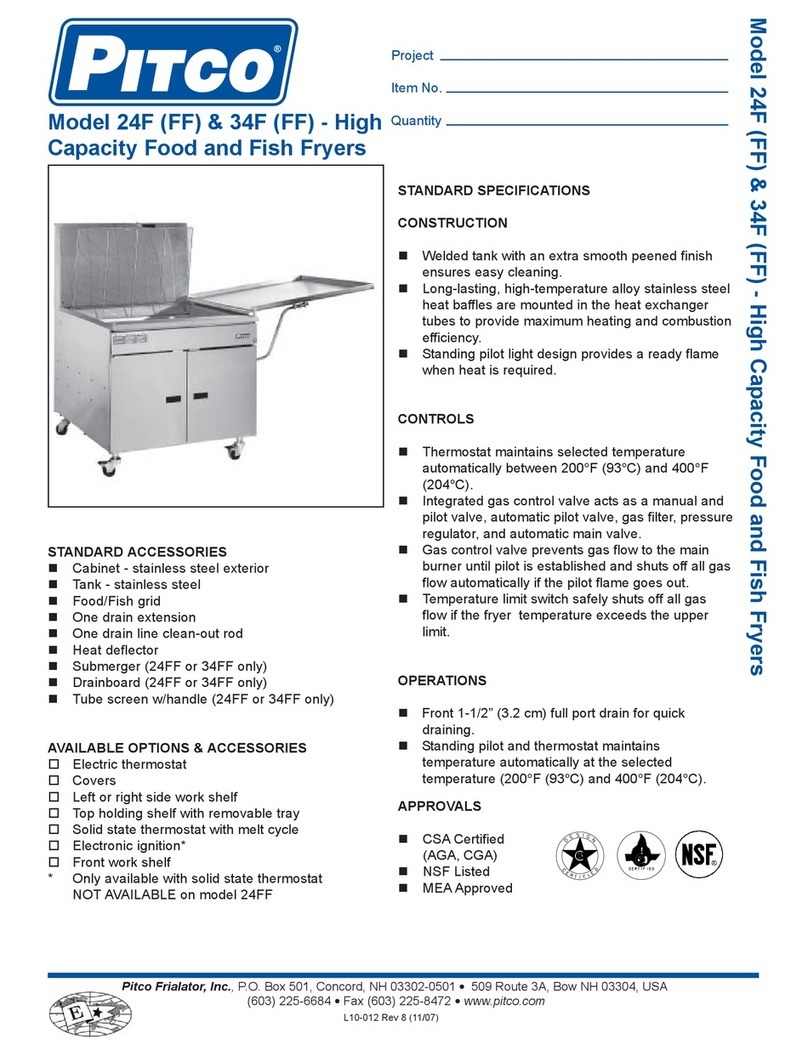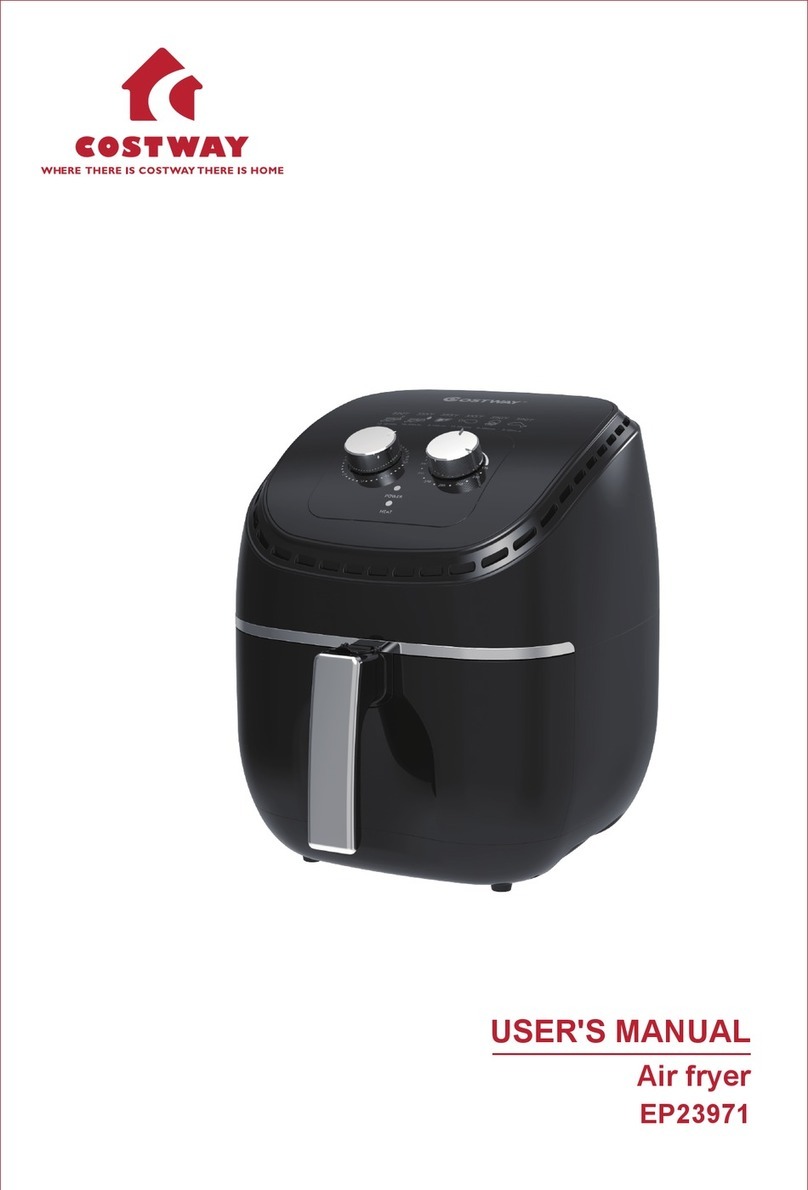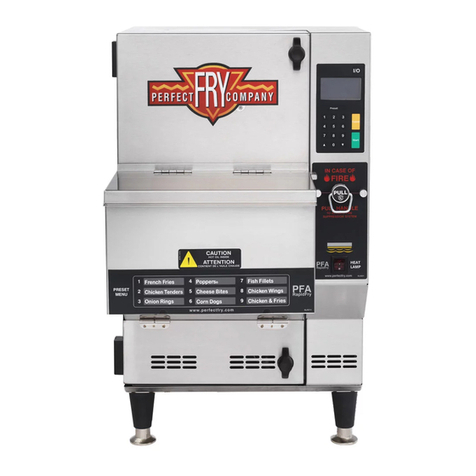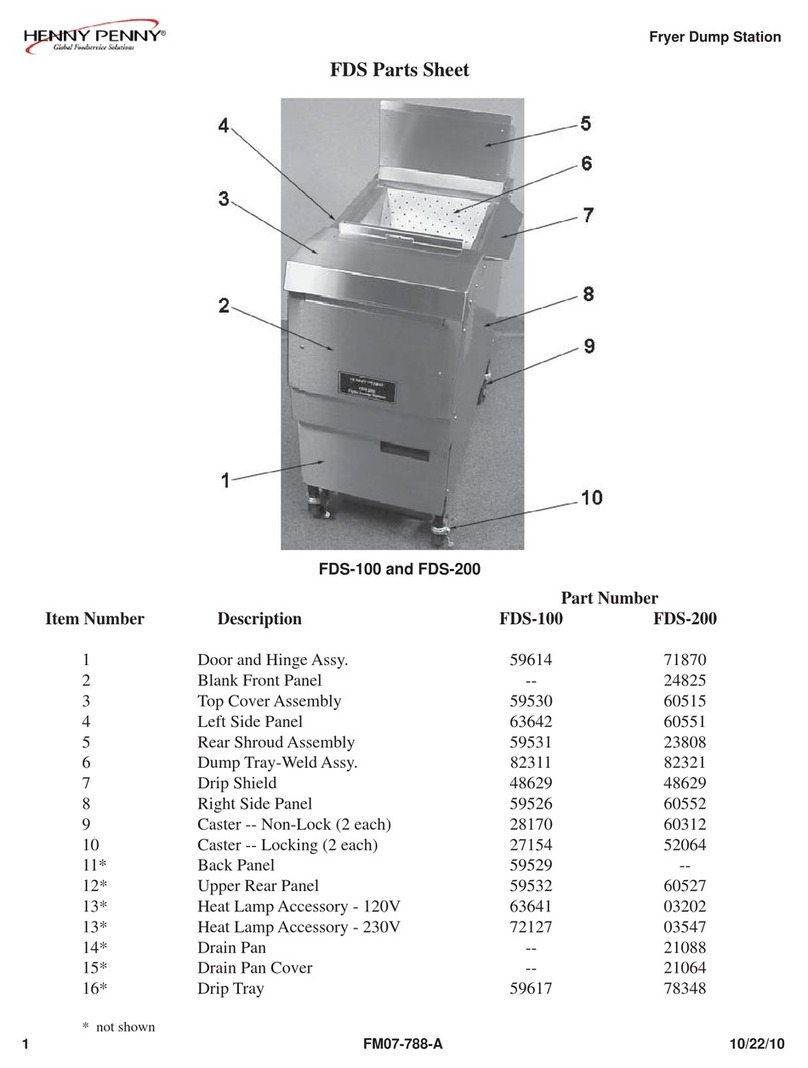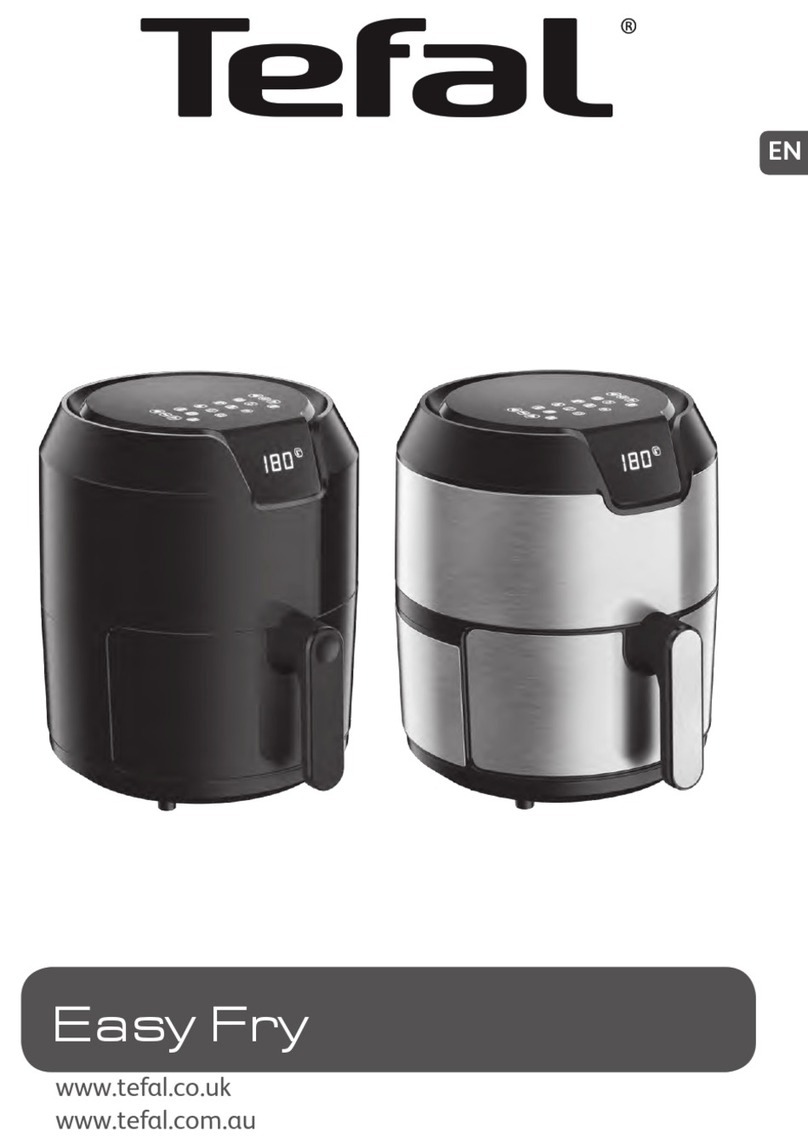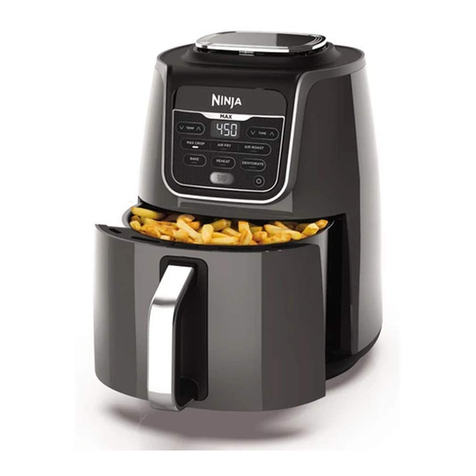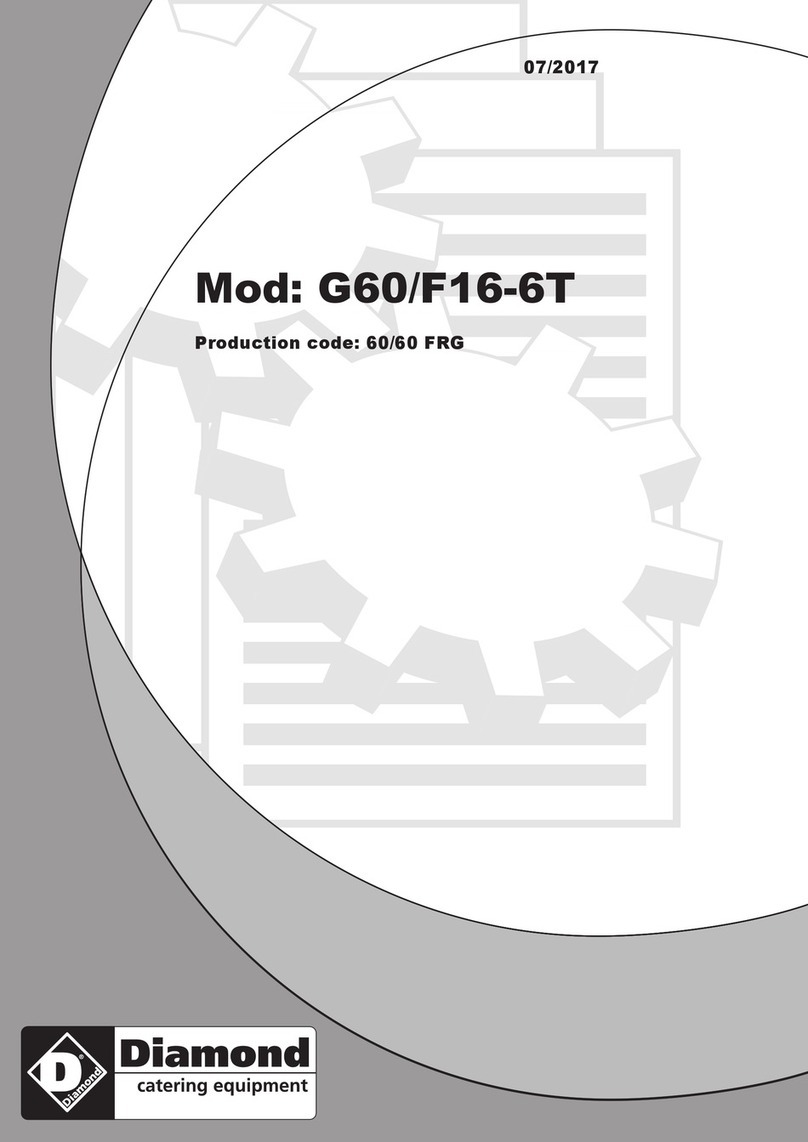AUSTHEAT AF822 Twin Tank User manual

OPERATING INSTRUCTIONS
FREE STANDING FRYERS
MODELS: AF822 Twin Tank
Version 1 units
Special Features:
Swing Up Ultra-Durable Stainless Steel Elements
Easy Clean Tank with Lockable 1” Drain
Adjustable Legs & Rear Castors
Digital LED Temperature Displays
Fish Plate & Fish Plate Lifter
Stainless Steel Baskets
Strainer
These instructions cover the models of High Performance Free Standing Deep
Fryers listed above. Although there are slight variances between models, the
installation, operation, care and maintenance procedure is the same for all.

Page 2
AUSTHEAT®Australia is a wholly Australian owned company, which has
been manufacturing quality commercial catering equipment for the food
service industry for more than 45 years. Austheat®products are
engineered and manufactured to the highest standards to provide
functionality, reliability and durability, and our quality products are
exported world-wide.
For a complete set of brochures please contact your nearest authorised
dealer or contact AUSTHEAT®directly at our head office.
AUSTHEAT®
PO Box 500
DEE WHY
NSW 2099
Australia
Telephone: 61 – 2 – 9971 1788
Facsimile: 61 – 2 – 9971 7211
© Copyright 2013 – Austheat®
All rights reserved. No part of this work may be reproduced or copied in any form or by any means,
electronic or mechanical, including photocopying or posting to a website, without the written permission
of the publisher. The material contained within this document is intended entirely for instructional
purposes.
Distributor: ………………………………………………………………
Date Purchased: ….. /….. /……… Serial Number: ……………….
Version Number: ……………

Page 3
CONTENTS
INTRODUCTION ...................................................................................... 5
GENERAL PRECAUTIONS ..................................................................... 5
PACKAGING............................................................................................ 6
COMPLIANCE.......................................................................................... 6
C-Tick:.......................................................................................................................6
ACSS (Advance Control Safety System):..................................................................6
INSTALLATION ....................................................................................... 7
Before Connection to Power Supply..........................................................................7
Electrical Connection.................................................................................................7
Electrical Requirements ............................................................................................8
GENERAL ARRANGEMENT................................................................... 8
CONTROL PANEL LAYOUT ................................................................... 9
Controls description...................................................................................................9
Thermostats............................................................................................................10
Thermal Cut-Out......................................................................................................10
What to do if the thermal cut-out trips for the first time:.................... 10
What to do if the thermal cut-out trips a second time: ...................... 11
Pilot Lights...............................................................................................................11
Temperature Display...............................................................................................12
OPERATION .......................................................................................... 12
Oil Level..................................................................................................................12
Filling with Liquid Oil................................................................................................12
Filling with Solid Oil and using the Melt Cycle.........................................................13
Cooking...................................................................................................................13
Tips for Healthy Frying......................................................................... 14
Various Types of Fats and Oils............................................................ 14
Extra Virgin Olive Oil...............................................................................................14
Tallow-based (Beef) Fats........................................................................................14

Page 4
Liquid Vegetable Oils ..............................................................................................15
Hardened/Creamed Vegetable Oils.........................................................................15
Saving Costs, Improving Oil Life and Increasing Efficiency ............. 15
TIPS ON DEEP FRYING ........................................................................ 16
GENERAL SAFETY............................................................................... 18
SAFETY FEATURES ............................................................................. 18
GENERAL FIRE SAFETY...................................................................... 18
COOKING SAFETY................................................................................ 18
CLEANING, CARE & MAINTENANCE .................................................. 19
TROUBLESHOOTING ........................................................................... 20
CIRCUIT DIAGRAM............................................................................... 21
Models: AF822........................................................................................................21
SPECIFICATIONS.................................................................................. 22
EXPLODED DIAGRAMS........................................................................ 23
AF822......................................................................................................................23
CONTROL PANEL COMPLETE .............................................................................24
ELEMENT BOX.......................................................................................................25
ELECTRICAL BOX ASSEMBLY.............................................................................26
Notes...................................................................................................... 27
Warranty Terms .................................................................................... 28

Page 5
INTRODUCTION
Congratulations on your purchase of this quality AUSTHEAT®product.
With proper care and management your new purchase will give you years
of trouble free service.
By reading these instructions carefully you can ensure that this machine is
used and maintained properly, helping your new investment to perform
well for you now, and to continue performing in the many years to come.
GENERAL PRECAUTIONS
These fryers must only be operated by qualified person(s) who are fully
versed in the operating and safety instructions described in this manual.
Servicepersons should be instructed to familiarise themselves with any and
all safety instructions described in this manual prior to commencement of
any maintenance or service.
In the case of new personnel, training is to be provided in advance. These
machines should not be operated by persons (including children) with
reduced physical, sensory or mental capabilities, or lack of experience or
knowledge, unless they have been given supervision or instruction
concerning the safe use of the appliance by a person responsible for their
safety.
These fryers should NOT be left unattended during operation.
These fryers are heating units, and, as with any commercial heating unit the
surfaces on them will get hot. Always be careful when near an operating
fryer, and ensure that any risk to unwary customers or staff is minimised
with additional signage if necessary. Due to the obvious heat hazard,
Austheat®recommends that these fryers be kept out of reach of children.
These fryers are for use with oil only. The fryers are not designed for use
with water or for such tasks as cooking pasta. Any use with water will void
the warranty for the fryer.
These fryers should be disconnected from all power via the main switch and allowed to
cool before attempting to carry out any cleaning and maintenance routines.
Austheat®will not accept liability if;
♦Non-authorised personnel have tampered with the machine.
♦The instructions in this manual have not been followed correctly.
♦Non-original spare parts are used.
♦The machine is not cleaned and maintained correctly.
♦There is any damage to the unit caused by the operator.

Page 6
PACKAGING
All care is taken when packing and Austheat®ensures that every unit is
functional and undamaged at the time of packaging.
The Package of these Fryers should include:
1) One AF822 Fryer
2) 2 Tank Lids
3) 2 Fryer Baskets
4) This manual
5) 2 Strainers
6) 2 Fish Plates
7) Fish Plate Lifter
8) Packaging materials
Any damage to the machine as a result of freight must be reported to the
Freight Company and to the agent responsible for the dispatch of said unit
within three (3) days of receipt. No claims will be accepted or entertained
after this period.
COMPLIANCE
C-Tick:
Austheat®products have been designed and manufactured to comply with
any and all specifications set out by the Australian Communications
Authority (ACA) in regards to Electromagnetic Compatibility. As testament
to such compliance these units bear the C-Tick symbol.
For further information contact the Australian Communications Authority, PO
Box 13112, Law Courts, Melbourne VIC 8010.
ACSS (Advance Control Safety System):
The ACSS framework is a stringent and specific set of voluntary
requirements aimed at the electrical safety, reliability and longevity of
equipment used in the foodservice industry.
The ACSS framework has been developed as both a guide to the
engineering and development of products as well as a guarantee to
consumers that Roband equipment bearing this mark not only meets the
requirements of the Australian Standards, they exceed them.
A unit bearing the ACSS mark is your guarantee that you are purchasing a
machine built to far exceed the Australian standards. The unit has been
designed to be safer, particularly from an electrical aspect, and last longer
than similar units on the market today.

Page 7
INSTALLATION
Before Connection to Power Supply
Remove all the packaging materials and tape, as well as any protective
plastic from the machine. Clean off any glue residue left over from the
protective plastic using methylated spirit.
Place the free standing fryer on a firm, level floor in the required position.
The legs can be adjusted for slightly uneven floors.
National Standards exist outlining the positioning, spacing and ventilation
requirements when installing new appliances. These Standards should be
consulted and new equipment should be installed accordingly. In any
situation where specifications allow a distance of less than 100mm we
would still recommend that a well-ventilated air gap of not less than
100mm be maintained. If the machine is near particularly heat-sensitive
materials common sense should be employed in determining sufficient
distancing.
Consideration should be given to securing the unit or limiting mobility if the
unit is hard-wired. Appropriate standards should be consulted when any
installation is undertaken to ensure compliance with all requirements.
Electrical Connection
Before connecting the fryer to the power supply ensure that all the controls
are in the “OFF” position.
A licensed electrician must install this fryer to comply with national
installation codes and regulations. The fryers are supplied ready for
connection to a three phase plus neutral and earth mains supply. Means
for disconnection from supply must be incorporated in the fixed wiring in
accordance with the wiring rules.
WARNING - THIS UNIT MUST BE EARTHED.
If the electrical mains supply cabling is damaged, the machine must
not be used until a suitably qualified person has replaced the supply
cabling and has deemed the unit to be functioning properly.
There are two main supply connection points in the unit. The first is through
the lower back panel at the rear of the unit. The second connection point is
through the base of the machine at the rear. Both connection points have
three choices of holes for the cable to pass through. A suitable cable gland
is required for the cable to pass through.
Each fryer must be connected to an adequately protected power supply
and an isolation switch mounted adjacent to, but not behind the fryer. This
switch must be clearly marked and readily accessible in case of fire.

Page 8
Electrical Requirements
The following table shows the electrical requirements for your fryer.
Model Total Power Amps/Phase Supply
AF812 15 kW 20.8 A 400-415 V AC, 3 Phase + N + E
AF812R 18 kW 25 A 400-415 V AC, 3 Phase + N + E
AF813 18 kW 25 A 400-415 V AC, 3 Phase + N + E
AF813R 21 kW 29.2 A 400-415 V AC, 3 Phase + N + E
AF822 15 kW 20.8 A 400-415 V AC, 3 Phase + N + E
GENERAL ARRANGEMENT
These fryers are designed as floor mounted units. They have a central
cooking tank with immersed electric elements. The controls are accessed
via the front door, located below the front display panel.
The elements are mounted in a box on top of the fryer at the rear. This
element box is pivoted and can be swung up to gain access to the tank and
to the elements. Cooking baskets can be hung on the rail on the front of the
element box allowing them to drain, after cooking, prior to serving.
To raise the element box firstly remove the fish plate from the tank, using
the lifter located on the bracket inside the door. A handle is provided that
swings out from underneath the element box. To lift the element box, grasp
the handle on the left side and swing it out towards the front of the fryer
through 90°. The handle can then be used to lift the element box to the
raised position.
When lifted to the raised position, a support latch on the right hand side of
the element box springs out to support the element box, enabling the
elements to be drained and cleaned.
WARNING: Always ensure the fryer is OFF, and is allowed to cool before
lifting the element out of the oil.
To lower the element box, lift with the handle a small amount to enable the
support latch to be pushed towards the right which will clear the box and
enable it to be lowered into the cooking position. The fish plate can be
returned to the tank.
WARNING: Immersing a hot element in the oil could cause a fire.
Access to the drain and the controls is gained by opening the front door. A
drain extension and the lifter for the fish plate are located in a bracket on the
inside of the door.

Page 9
The unit can be moved by lifting from underneath the front, just above the
door, and pulling it along on the rear castors.
CONTROL PANEL LAYOUT
Take a moment to familiarise yourself with the general arrangement of the
fryer before going any further. The controls are located behind the door on
the front of the fryer. Refer to the figure above.
Controls description
The controls consist of the following;
•A main isolating switch, labelled “ON/OFF SWITCH”.
•2 primary thermostats, labelled “PRIMARY THERMOSTAT”.
•2 secondary thermostats labelled “SECONDARY THERMOSTAT”.
•2 thermal overloads labelled “THERMAL CUT-OUT RESET BUTTON”
•2 melt cycle switch’s labelled, “MELT SWITCH”.
•2 digital temperature displays. Please note that this item is not visible
on the control panel. It is mounted behind the display panel on the
front of the fryer, above the door.
•2 thermostat selector switches. These are mounted on either side of
the fryer on the front display panel next to the temperature displays.
•A safety cut-out switch which prevents the fryer from working when
the elements are in the raised position. Please note that this switch is
not visible on the control panel. It is mounted inside the element box.
•Various pilot lights indicating states of operation. These will be
described in the following text.

Page 10
Thermostats
These fryers have 4 thermostats 2 primary and 2 secondary. There is one
primary and one secondary thermostat per tank. Only one thermostat per
tank is in use at a time. The thermostat selector switch on the front
display panel is used to select which thermostat is used to control the
fryer.
The secondary thermostat is designed to be used as a back up control if
the primary thermostat fails, or as an ‘IDLE’ thermostat when the oil needs
to remain hot but not cook.
If failure occurs in the Primary thermostat, set the thermostat selector
switch to the IDLE position to continue cooking with the secondary
thermostat. In the IDLE position, only the secondary thermostat is used –
by adjusting the setting of the secondary thermostat you can continue
operation. This will allow fryer to continue functioning until the primary
thermostat is repaired. After the repair has been made the switch can be
returned to the PRIMARY position.
Thermal Cut-Out
These fryers have a thermal cut-out control fitted for each tank. This
control is designed to function when the oil temperature reaches a
dangerous level. If the oil reaches that level the thermal cut-out will open,
cutting all power to the elements.
When the thermal cut-out has tripped, the red button on the control panel
will protrude out from the panel as an indication that this has occurred. If
the thermal cut-out has tripped, it indicates that there is an underlying
problem that has caused the oil to reach a dangerous temperature.
Note: It is important to understand that old, dirty oil can contribute to
nuisance tripping of the thermal cut-out. Always ensure that your oil is
maintained and replaced when necessary.
What to do if the thermal cut-out trips for the first time:
There are a number of possible causes of this behaviour. One of the
possibilities is a thermostat failure. You may follow the procedure below as
a first step to rectifying the problem.
1. Switch the fryer OFF and allow it to cool to approximately 100°C.
2. Reset the thermal cut-out by pressing the red reset button. The
control is reset when the button remains depressed. An audible click
will also be heard.
3. Re-set the thermostat to the normal operating temperature and
observe the unit closely. If the unit trip the Thermal Cut-out switch

Page 11
again, continue to step 4. If no cut-out occurs within an hour,
continue to use the machine and monitor the temperature of the oil.
4. If the unit has activated the Thermal cut-out switch twice in a short
time, set the thermostat selector switch to the SECONDARY/IDLE
position. This procedure assumes you were using the primary
thermostat. If you were using the secondary thermostat when the
fault occurred then select the PRIMARY/COOK position in this
procedure.
5. Cooking can now resume.
If the fryer continues to perform without any further tripping of the thermal
cut-out then there is a strong possibility that the thermostat in use at the
time is faulty. This should be attended to by qualified electrical personnel.
What to do if the thermal cut-out trips a second time:
If the thermal cut-out trips again after following the procedure above it
indicates that there is a serious electrical problem that needs to be
addressed immediately. In such cases follow the procedure below.
1. Turn OFF the fryer immediately. There is a danger of fire.
2. DO NOT reset the thermal cut-out.
3. Seek advice from qualified electrical personnel. They will be
able to check the fryer for faults and make any necessary
repairs.
Resume operation of the fryer only after it has been cleared for use by the
electrical personnel charged with the repair.
Pilot Lights
The control panel has a number of pilot lights. These pilot lights indicate
the status of the fryer and are described below.
•The green pilot light above the main isolating switch illuminates
when the fryer is switched on. This indicates that mains power is
being supplied to the fryer.
•The amber pilot light beside the melt switch is illuminated when the
melt cycle is being used.
•The amber pilot lights above each of the thermostats is illuminated
when the respective thermostat switches on and heating is taking
place. When the thermostat cycles off after reaching the set
temperature the pilot light will be extinguished.

Page 12
Temperature Display
The temperature displays can be seen on the display panel, located on
the front of the fryer above door. It displays the current temperature of the
oil in each tank.
OPERATION
Oil Level
A raised form on the inner left hand side of the left tank and the inner right
hand side of the right tank indicates the oil level range. The upper and
lower extremities of the raised form indicate the upper and lower oil level
limits.
The fryer should be filled with oil to a level which lies within the length of
the form. Please note the following.
•The danger of fire exists if the oil level is below the minimum
indicated level.
•The danger of surge boiling exists if the oil is above the
maximum indicated level.
•The danger of surge boiling also exists if over-wet or too large a
load is used
Refer to the specifications page for the volume of oil required for your
particular model. Filling with Liquid Oil
Fill the tank with the required volume of oil using the following procedure.
•Ensure all controls are OFF, the drain valve is closed and the
elements are cold.
•Place the strainer in position, lower the elements and place the fish
plate in position.
•Fill the tank with the required volume of oil.
The fryer is now ready for cooking.

Page 13
Filling with Solid Oil and using the Melt Cycle
If solid oil or shortening is preferred this may be melted after filling by
using the melt switch and the following procedure.
•Ensure all controls are OFF, the drain valves are closed and the
elements are cold.
•Place the strainers in position and lower the elements. Do not place
the fish plates into the tank at this time.
•Fill the tank with solid oil / shortening sufficiently to cover the
elements.
•Switch the fryer ON at the main isolating switch.
•With the thermostat selector switch set to the PRIMARY position, set
the primary thermostat to 120°.
•Switch the melt switch to ON.
With this setting the solid oil will be melted. 2 full tanks will take
approximately 40 minutes to melt. While melting, additional solid oil will
need to be added to achieve the correct oil level. Care should be taken to
ensure that the total volume of oil placed in the tanks is neither under or
over the oil level marks as described above in “Oil Level”. During this
phase the fryer will remain protected by the control thermostat and the
thermal cut-out.
When melting is complete the melt switch should be returned to the OFF
position and the fish plate lowered carefully into the tank.
The fryer is now ready for cooking.
Cooking
1. Fill the fryer tanks with oil as described above.
2. Rotate the main switch to the “ON” position. The green pilot light will
illuminate, indicating that the power is on.
3. Rotate the thermostat selector switches to the COOK position.
4. Rotate the primary thermostat knobs to select the desired cooking
temperature. For cooking, a setting of between 170° and 180°C
should suffice but experience will dictate the best temperature for the
particular food being cooked. When the temperature has been set the
associated amber pilot light will illuminate, indicating that heating is
taking place. When the oil has reached the set temperature the amber
pilot light will be extinguished. The thermostat will then continue to
cycle on and off, maintaining the set temperature. The amber pilot
light will also cycle on and off with the thermostat.

Page 14
Once the fryer has reached the set temperature, it is ready for cooking to
commence. The set temperature will be displayed on the temperature
display panel. Note: the temperature displayed will fluctuate and will not
display a static value equal to the set temperature of the thermostat.
Lower the filled baskets into the oil carefully and do not over fill them.
Refer to the specifications page to determine the maximum load you
should work with. Shaking the baskets occasionally during cooking will
help prevent the food from sticking together.
Cooking time will vary with the type of food product being cooked and
experience will guide you. With use, standard batch sizes, temperatures
and cooking times can be established to enable consistent results.
To obtain the optimum results from your fryer we recommend the following
guidelines.
•Keep salt away from the cooking oil. Salt degrades the oil.
•Check your oil to food ratio, 6:1 oil to food is recommended.
•Top up the cooking oil regularly.
Tips for Healthy Frying
Are you concerned about your customers’ health? Would you like to
improve the flavour and nutritional value of your fried product? And would
you like to save money doing so? Then read on and take the first step
towards a higher quality healthier product that actually can help save you
money…
Various Types of Fats and Oils
Different types of oil or fat used to fry foods affect the overall nutritional
quality of the finished product. Many of the various types of fats and oils
available on the market are not suitable for cooking over long periods of
time at high temperatures, as happens in deep-frying.
Extra Virgin Olive Oil
The flash point of Extra Virgin Olive Oil is considerably lower than the more
refined Olive oils and should not be used for high temperature frying.
Tallow-based (Beef) Fats
The most commonly used fat due to its cheaper cost and relatively longer
fry life. This medium is not recommended due to it’s association with
increased risk of heart disease.

Page 15
Liquid Vegetable Oils
While most vegetable oils are recommended for cooking, many of them
are not suitable for deep-frying. Higher temperatures break down the oil
faster and by-products often have an unpleasant flavour and may also
have an association with increased risk of heart disease.
Hardened/Creamed Vegetable Oils
These products may have a longer fry life than their liquid oil equivalents,
but the components added during the hardening process increase the risk
of heart disease.
The Heart Foundation recommends frying oils that have a nutrient profile
taking all these factors into account. These include:
1. Oils from specially bred seeds e.g. Sunola, Liquid Gold
2. Industry blends of fats and oils
Saving Costs, Improving Oil Life and Increasing
Efficiency
Food quality and operating efficiency is improved by cooking in regularly
filtered oil. Long oil life can be achieved by frequently filtering the oil inside
the deep fryer. This allows the oil to work at greater efficiency for a longer
time.
This increased efficiency can be associated with power cost savings and a
longer fry life for the oil.
Several factors that shorten the fry life of the oil include the presence of
water, salt, emulsifiers, seasoning, light and detergent.

Page 16
TIPS ON DEEP FRYING
1. Use thick, straight cut chips (greater than 13mm) or
wedges
•Thin chips and crinkle chips absorb more oil and therefore use
up more oil from the fryer
•If the chips are frozen, don’t thaw. Water from thawed chips
damages the oil
2. Cook at 180°C
•Food won’t cook more quickly at temperatures above 180°C
•Higher temperatures damage the oil
•Damaged oil: - cooks more slowly.
-uses more electricity to cook the food.
-takes longer to get back up to temperature.
•Lower temperatures produce greasy food
•Turn fryer to 140°C during quiet times to save power and save
the oil
3. Cook chips in a separate fryer
•Fresh batter mix used for battered food, crumbs from crumb
coatings, seasonings, sausages and seafood all damage the
oil.
•If you have enough fryers, keep one fryer for chips only, this oil
will last longer
4. Cook chips for 3-4 minutes
5. Avoid big drops in oil temperature
•Big drops in temperature will damage the oil more quickly.
•Put small loads in the baskets
•If you have enough fryers, put baskets in alternate fryers.
•Keep fryers topped up with fresh oil. Don’t top up whilst
cooking food.

Page 17
6. Drain food well
•Vigorously shake the basket of cooked food twice and hang it
for at least 20 seconds over the hot fryer. This returns some oil
to the fryer
7. Look for signs of oil degradation
•If the oil is damaged (eg dark colour, smoking) discard it all.
8. Filter oil daily
•Use a funnel or a filtering machine
•The cost of a filtering machine will be offset by your savings on
the oil
•Filtering extends the useful life of the oil
•Skim the surface of the oil frequently while cooking
9. Clean fryer frequently
•Detergent damages the oil. If you use detergent, rinse well
after with a solution of white vinegar and water (1 cup of
vinegar in a 20 litre bucket of water.) Finally rinse with water.
10. Cover the fryer when not in use
•As light, dust and air damage oil, cover the fryer overnight and
other times during the day when oil is cool.

Page 18
SAFETY
GENERAL SAFETY
This machine contains no user-serviceable parts. Austheat®Australia,
one of our agents, or a similarly qualified person(s) should carry out all
repairs. Any repair person(s) should be instructed to read the Safety
warnings within this manual before commencing work on these units.
Steel cutting processes such as those used in the construction of this
machine result in sharp edges. Whilst any such edges are removed to the
best of our ability it is always wise to take care when contacting any edge.
Particular care should be taken to avoid contact with any steel edge, and
warnings should be given in regards to the danger of such contact to any
repair or maintenance person(s) prior to commencement of any servicing.
Do not remove any cover panels that may be on the machine.
This unit can get very hot, ensure everyone is aware that the machine is
operating and take care to avoid contact with hot surfaces.(refer to
installation for guide to ventilation)
Always ensure the power cable is not in contact with hot parts of the
machine when in use, and ensure that if the cable is damaged in any way
that is replaced immediately
SAFETY FEATURES
All fryers in this range are equipped with a thermal cut-out, to protect
against abnormal oil temperatures and a safety switch to prevent
operation when the elements are in the raised position.
Refer to the Control Panel Layout section above for a functional
description of these devices.
GENERAL FIRE SAFETY
Before using any fryer adequate safety measures should be in place.
Such measures should include, but not be limited to, having an
appropriate fire extinguisher or fire blanket located nearby in case cooking
oil ignites. Refer to the appropriate regulations pertaining to your operating
environment for details of the correct fire prevention measures required.
COOKING SAFETY
WARNING: Hot oil does not “look” hot. Do not be fooled into thinking that
the oil is cool because of its placid appearance.

Page 19
WARNING: Ensure that oil is changed or filtered regularly. Old or dirty oil
has a lower flash point and is more prone to surge boiling.
WARNING: Always be careful when cooking frozen or over-wet food
products as these items are more prone to surge-boiling and are more
likely to result in the “spitting” of hot oil.
WARNING: Do not overfill the cooking baskets beyond the guidelines.
There is a danger of surge boiling when attempting to cook too much
product.
WARNING: Never use copper or brass utensils in the cooking oil.
CLEANING, CARE & MAINTENANCE
Attention to regular care and maintenance will ensure long and trouble
free operation of your fryer.
•The Fryer should be cleaned out daily, or more often if necessary.
•Ensure the power is off and the fryer is cool before attempting to
drain the cooking oil or clean any part of the machine.
•Wipe the fryer down with warm soapy water using a damp sponge
or cloth. Do not spray the fryer with a water jet from a hose or
pressure cleaner.
•Filter the cooking oil daily if the fryer is constantly in use.
Although every care is taken during manufacture to remove all sharp edges,
care should be taken when cleaning to avoid injury.
Caution: Some cleaning agents can damage stainless steel or the
polycarbonates and plastics used in switches and pilot lights, usually
through prolonged use. For this reason we recommend cleaning with
soapy water only. Any damage to the unit through the use of harsh or
improper cleaning agents is entirely the fault of the user.
Warning: No parts of this these units, with the exceptions of the
cooking baskets, lids, fish plates and strainers, should ever be
immersed in water for cleaning or any other purposes.
Note: We recommend that all electrical appliances be inspected
annually with reference to applicable Australian Standards to ensure
compliance with changing Standards is maintained. Such inspections

Page 20
should be carried out by a suitable person conversant with the latest
Standard updates.
TROUBLESHOOTING
If the fryer does not function check the following points before calling
for service.
The power is switched “on”, both on the unit and at any other point
that supplies power to the machine (eg an isolating switch on the
wall).
The mains power is not faulty.
The temperature has been set correctly and the thermal cut-out
has not tripped. Refer to the “Thermal Cut-Out” section above for
more information on this control.
The thermostat knobs are not loose or broken, rendering the
thermostats inoperable.
The circuit breakers located inside the door behind the drains are
all in the “on” position”.
Table of contents
